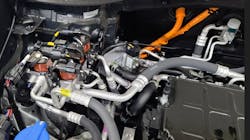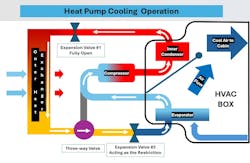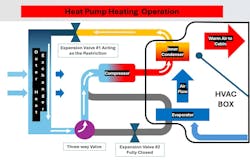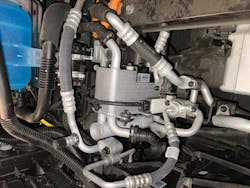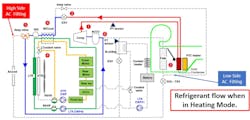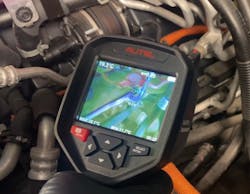Key Highlights: Technicians Need to Know
- Vapor-injected scroll compressors enable effective operation in sub-zero temperatures, enhancing cold-weather performance.
- Modern systems utilize reversible refrigerant flow, allowing simultaneous heating and cooling with a single, adaptable setup.
- Technicians must understand complex refrigerant routing, use specialized diagnostic tools, and follow precise service procedures for maintenance and repairs.
- A breakdown of the heat pump systems from seven OEMs: Tesla, GM, Ford, Hyundai, Kia, Nissan, and Toyota.
While often overlooked by consumers, heat pump systems have become one of the most influential technologies in modern EV and hybrid vehicles. They provide energy-efficient heating and cooling while preserving precious battery range.
As electric and hybrid vehicles increasingly replace traditional internal combustion engine (ICE) models, automakers have had to re-imagine nearly every vehicle system. One of the most critical challenges has been managing cabin heating, especially in cold climates where traditional methods either aren’t available or do not perform efficiently. In ICE vehicles, waste engine heat is plentiful and was used to heat the interior of the vehicle for years. In electric vehicles (EVs), however, that luxury does not exist. Many EVs and hybrid vehicles relied on Positive Temperature Coefficient (PTC) resistive heaters to provide the needed heat to the passenger compartment. But even with the simple, dependable fast warm up that the PTC heater provided; they are power-hungry devices that can significantly reduce EV range in cold weather.
Fortunately, most of these vehicles were already equipped with air conditioning systems and relied on an air conditioning compressor to provide cooling to the passenger cabin. This made it easier for manufacturers to transition to reversible heat pump designs, as they could build on existing components and infrastructure. The automotive heat pump system achieved both: a more efficient heating solution and the preservation of its full cooling capabilities.
In this article, we’ll examine what automotive heat pumps are, how they work, and examine some manufacturer highlights. We'll also look at concerns technicians need to be aware of when diagnosing them, what problems have surfaced in real-world use, and how this technology is likely to evolve. By the end, you'll understand why heat pumps are at the center of EV/hybrid thermal management and why mastering them is essential for today’s automotive professionals.
What Is a Heat Pump and Why Does It Matter in EVs and Hybrids?
Essentially, a heat pump is a thermodynamic system designed to move heat. It typically works by taking heat from a lower temperature source and releasing it at a higher temperature. In the case of EVs/hybrids, the system extracts heat from the ambient environment and delivers it to the cabin or to vehicle systems such as the battery pack. In warm weather, it can reverse its function, acting like a traditional air conditioning unit to cool the vehicle’s interior or remove heat from the high-voltage battery and other heat producing equipment.
The importance of this system in EVs/hybrids cannot be overstated. Earlier EVs/hybrid vehicles relied solely on resistive PTC-type heaters, which use electric current to create heat — a method that is simple but extremely inefficient. When cabin heating is needed in cold weather, resistive heaters consume a large amount of energy, sometimes reducing driving range by 30 percent or more. Heat pumps, by contrast, use a small amount of energy to move existing heat rather than generate it, delivering the same cabin comfort with far less battery drain. This improved thermal efficiency translates directly to extended driving range and better winter usability.
How Heat Pump Systems Work in Vehicles
In today’s heat pump-equipped vehicles, the HVAC system is designed to reverse the flow of refrigerant to either heat or cool the cabin using a single, flexible system. During heating mode, the system functions similarly to an air conditioner in reverse. Refrigerant first passes through the outside heat exchanger (normally the condenser in cooling mode), which now acts as an evaporator. As cold outside air flows over this component, the refrigerant absorbs heat energy, even in low ambient temperatures and evaporates into a low-pressure vapor.
This vapor then flows to the electric compressor, which compresses it into a high-pressure, high-temperature gas. The hot refrigerant then moves into what would typically be called the evaporator, located inside the cabin, but in heating mode it functions as a condenser. There, the refrigerant releases its heat into the cabin air or to a coolant loop, warming the interior.
In cooling mode, the system returns to a traditional A/C cycle. The cabin heat exchanger reverts to being the evaporator, pulling heat from inside the vehicle, while the front heat exchanger resumes its role as the condenser, releasing that heat into the outside air.
This reversible refrigerant flow is made possible using valves and flow control components, such as a reversing valve or multi-port expansion valves, which direct the refrigerant through different pathways depending on whether the system is heating or cooling. Some systems also include a vapor-injected scroll compressor for improved performance in extremely cold conditions.
The Role of Vapor-Injected Scroll Compressors
One of the innovations that has allowed automotive heat pumps to function effectively in cold climates is the vapor-injected scroll compressor. This compressor design is a major upgrade over standard compressors, particularly in sub-zero conditions.
The vapor injection technique involves splitting the refrigerant flow. A portion is routed through a secondary circuit, where it is expanded and evaporated to form a cool vapor. This vapor is then injected midway into the scroll compressor. By doing so, the system increases mass flow and compression efficiency, improving heating capacity even when the ambient temperature is below minus 4 degrees Fahrenheit (minus 20 degrees Celsius). The vapor injection system also reduces the temperature difference across the compressor, helping to prevent overheating and improving long-term durability.
This compressor design is now featured in vehicles such as the Tesla Model Y, Ford F-150 Lightning, Hyundai Ioniq 5, and others. It has become the gold standard for cold-weather heat pump performance in EVs.
Real-World Benefits and Range Preservation
Heat pumps provide quantifiable benefits to EV/hybrid drivers, especially in colder climates. Numerous real-world tests and independent studies have shown that vehicles equipped with heat pumps keep a higher percentage of their normal range in winter conditions compared to those using resistive heaters.
For example, Tesla vehicles equipped with their octovalve heat pump system have demonstrated winter range retention as high as 85 to 90 percent under sub-freezing conditions. Hyundai’s Ioniq 5 and EV6 models perform similarly, with winter range drops of less than 10 percent. In contrast, early-generation Nissan Leaf vehicles without heat pumps often saw winter range drops of 30 percent or more. GM’s Cadillac Lyriq and Chevrolet Blazer EV, while equipped with heat pumps, still switch to resistive heating below minus 13 degrees Fahrenheit (minus 25 degrees Celsius), leading to slightly lower winter performance.
This difference in efficiency matters not only for range anxiety but also for occupant comfort. Heat pumps provide quicker warm-up times and better temperature stability, all while consuming less energy.
Manufacturers and Their Approaches
Tesla: Intelligent Thermal Management
Tesla’s heat pump system, introduced in the 2021 Model Y, features a vapor-injected scroll compressor and a unique part called the super manifold. The super manifold is a compact assembly housing multiple thermal management components like the octovalve, heat exchangers, sensors, and connections for coolant and refrigerant lines. The super manifold routes coolant and refrigerant between the cabin, battery, and powertrain components based on thermal demands. Tesla even uses the heat from the blower motor to aid in the warming of the passenger cabin. Combined with sophisticated software logic, the system ensures that heat is always used or stored optimally.
The Tesla system operates effectively down to minus 22 degrees Fahrenheit (minus 30 degrees Celsius) and uses over-the-air (OTA) updates to fine-tune its behavior over time. In effect, it’s a dynamic and intelligent system that adapts to environmental conditions and driver behavior, significantly improving winter performance.
GM: Ultium Energy Recovery
General Motors has integrated heat pumps across its Ultium-based EV lineup, including the Cadillac Lyriq, Chevy Equinox EV, Blazer EV, and Hummer EV. These systems include a patented energy recovery function that captures waste heat from the battery, motors, and power electronics. This recovered heat is used to warm the cabin or precondition the battery before charging.
However, GM’s system may not be as capable at lower temperatures as some others. Below minus 13 degrees Fahrenheit (minus 25 degrees Celsius), it automatically disables the heat pump and switches to PTC resistive heating. While this ensures reliability, it sacrifices efficiency and range. Nevertheless, the system is reported to improve cold weather driving range by 10 percent under typical winter conditions.
Ford: Engineering for Durability and Range
Ford switched to a vapor-injection heat pump system in the 2022 model F-150 Lightning and 2021 Mach E. The system includes three electronic expansion valves, two cyclonic liquid-gas separators and a large suction accumulator to prevent liquid “slugging events” from entering the compressor. Any liquid refrigerant, even small droplets, which enter the compressor may not only cause damage, but this refrigerant liquid reduces the compressor’s efficiency. Providing only gas-phase refrigerant, under low-load or cold climate conditions maximizes the system’s efficiency.
Ford's heat pump system can function in various modes, managing complex thermal demands from the passenger cabin, battery, and drivetrain. Ford kept a 5-kW resistive PTC heater in the cabin for backup heating, ensuring consistent performance even in severe conditions.
Hyundai and Kia: Quiet Leaders in Efficiency
Hyundai Motor Group has quietly become a leader in heat pump technology. Vehicles like the Hyundai Ioniq 5, Kia EV6, and Genesis GV60, feature vapor-injected compressors, waste heat recovery, and seamless integration with battery thermal systems. Real-world testing has shown these vehicles keep 90 percent or more of their rated range in sub-zero conditions.
Hyundai’s systems are not only efficient but also dependable, with fewer service-related complaints than other OEMs. Their approach focuses on smart control logic and thermal synergy rather than proprietary hardware like Tesla’s super manifold.
Nissan Leaf: An Orifice Tube
The Nissan Leaf's heat pump system uses both an expansion valve and an orifice tube, depending on the specific mode of operation. In cooling mode, the system employs a thermal expansion valve (TXV) to regulate the flow of refrigerant into the evaporator. During heating mode, the system incorporates an orifice tube as a fixed metering device. This orifice tube creates a pressure drop, allowing the refrigerant to absorb heat effectively. The Leaf also incorporates a PTC heater for cold weather reliability.
Toyota: Dependable and Evolving
Toyota’s Prius Prime PHEV features a heat pump system that uses a gas injection scroll compressor and a compact liquid-gas separator. This allows the vehicle to work efficiently in temperatures down to 14 degrees Fahrenheit (minus 10 Celsius) without engaging the gasoline engine. While effective, Toyota’s system does not yet match the cold-weather performance of Tesla or Hyundai.
The bZ4X and Lexus RZ use updated heat pump systems, and Toyota is expected to adopt more advanced thermal technologies in future models as EV adoption expands.
Diagnostics and Servicing Heat Pump Systems
As heat pumps become standard equipment, technicians must become familiar with their operation, failure modes, and diagnostic procedures. One of the most critical aspects of heat pump service is refrigerant and oil charge levels. These systems are extremely sensitive to refrigerant and oil charge levels and even small deviations can impact performance.
In modern automotive heat pump systems like those found in vehicles from Kia and other manufacturers, traditional A/C pressure gauge readings can be misleading or even meaningless without proper context. Unlike older A/C systems with the traditional refrigerant flow paths, heat pump setups use complex multi-valve configurations, vapor injection, and variable-speed electric compressors. These systems constantly adjust refrigerant routing based on cabin demand, battery conditioning, and ambient temperature. As a result, pressure gauges connected at standard service ports may not reflect the actual operating pressures inside the active loop at a given moment. For example, the system could be routing refrigerant through an isolated sub-circuit or temporarily idling the compressor, causing gauges to show low or even static pressures despite the system functioning correctly. Diagnosing these systems requires more than just gauges, it will require scan tool data understanding, knowledge of refrigerant flow modes, and sometimes even thermal imaging to interpret system behavior accurately.
Most manufacturers provide detailed refrigerant flow diagrams for heat pump-equipped vehicles. These not only illustrate how the system routes refrigerant through various components during different heating and cooling modes, but they also show the components used in the system. This can be a great aid in diagnostics and proper service procedures.
When servicing heat pump-equipped vehicles, removing or recharging the refrigerant will involve a special procedure to allow access to all the internal passages and components, due to the system’s multiple refrigerant paths.
Unlike conventional A/C systems, these vehicles can trap refrigerant in dormant parts of the circuit and not allow the refrigerant to be fully recovered by simply attaching an A/C recovery machine.
To ensure complete and safe refrigerant recovery, the system must be powered on and placed in an operational mode that fully activates the refrigerant circuit. This is typically done using a scan tool to command the HVAC system into a “refrigerant evacuation” or “service mode” or “full flow mode” which opens all necessary valves, solenoids, and flow paths, and may also engage the compressor. Following this procedure ensures that all refrigerant is properly evacuated before any disassembly is performed. Automakers like GM, Tesla, VW, and others outline these steps in their official service procedures to ensure proper and thorough evacuation.
Without this step, a significant amount of refrigerant can remain trapped in isolated components, posing safety risks and compromising system performance after reassembly. The same procedure must be used again to properly fill/recharge the system after the service or replacement of parts has been completed.
Always consult the vehicle manufacturer’s service procedures and use a certified recovery machine to safely extract and contain the refrigerant before opening any part of the system. And use all the needed precautions around any of the A/C systems’ high-voltage equipment.
Scan tools are essential for diagnostics and service. Technicians should monitor parameters like compressor RPM, valve positions, refrigerant pressure and temperature, and ambient sensor data. For example, a failed temperature sensor can cause the system to misjudge whether heat should be drawn from the outside or whether to switch modes entirely.
Listen for compressor pitch changes or unusual vibrations, which can indicate bearing or internal damage. Modern systems may run the compressor even when the HVAC is off to maintain battery thermal stability.
Software updates are also crucial. Tesla, GM, Hyundai, Ford, and others all release periodic updates to improve system behavior, correct bugs, or recalibrate control logic. Some vehicles may need a software update rather than a hardware replacement to resolve HVAC concerns.
Recalls and Real-World Issues
Even with their efficiency benefits, heat pump systems are not immune to problems.
Tesla experienced issues with early Model Y systems, where faulty sensors or misbehaving valves led to heat loss in extreme cold. A recall affecting more than 25,000 vehicles resulted in an OTA update and, in some cases, sensor replacement.
GM vehicles have faced criticism for losing heat below minus 13 degrees Fahrenheit (minus 25 degrees Celsius), though the company clarified that this is intentional fallback behavior. Still, customers expecting consistent cabin heat have reported dissatisfaction.
Hyundai issued service campaigns for early Kona EVs due to refrigerant contamination, which affected heat pump performance. These campaigns included flushing, recharging, and reprogramming the HVAC module.
Nissan's Leaf, particularly in early models, suffered from sticking flow valves that caused intermittent heating. Software updates and mechanical valve replacements resolved most of these issues.
The Road Ahead: Smarter, More Efficient Thermal Management
Heat pump systems are expected to undergo further development in the future. Manufacturers are already exploring AI-driven thermal algorithms that learn from driver habits and environmental conditions. Future systems will be even more integrated, allowing waste heat from every component including regenerative braking systems to be reused.
Vapor-injected compressors will become the norm, and newer refrigerants with better thermodynamic properties are being evaluated to improve performance further. For technicians, this means training and scan tools will need to keep pace. Service information will become more specialized and needed for HVAC diagnostics.
What This Means for Technicians: Understanding the System
Automotive heat pumps are no longer high-tech extras — they’ve become essential systems that directly affect the comfort, efficiency, and range of today’s electric and hybrid vehicles. For technicians, understanding how these systems work and how they differ from traditional HVAC setups is critical for correct diagnostics and effective repairs. Heat pump systems involve advanced refrigerant routing, electronic valve control, and integrated battery thermal management, requiring a deeper level of system knowledge and confident scan tool use. As EV and hybrid adoption continues to rise, technicians who stay current with this technology will be better prepared to diagnose performance issues, solve heating and cooling problems, and meet customer expectations for comfort and efficiency, whether it's during summer heat or winter cold.
About the Author

Jeff Taylor
Jeff Taylor is a seasoned professional at CARS Inc. in Oshawa with 40 years in the automotive industry. As a skilled technical writer and training developer, he holds licenses in both automotive and heavy-duty vehicle repair. Jeff excels in TAC support, technical training, troubleshooting, and shaping the future of automotive expertise.
